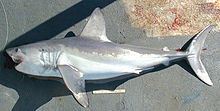| Lamna Temporal range: Earliest Danian to Present | |
|---|---|
 | |
| Porbeagle (L. nasus) | |
 | |
| Salmon shark (L. ditropis) | |
| Scientific classification | |
| Domain: | Eukaryota |
| Kingdom: | Animalia |
| Phylum: | Chordata |
| Class: | Chondrichthyes |
| Subclass: | Elasmobranchii |
| Division: | Selachii |
| Order: | Lamniformes |
| Family: | Lamnidae |
| Genus: | Lamna Cuvier, 1816 |
| Type species | |
| Lamna nasus Bonnaterre, 1788 porbeagle | |
| Synonyms | |
| |
Lamna is a genus of mackerel sharks in the family Lamnidae, containing two extant species: the porbeagle (L. nasus) of the North Atlantic and Southern Hemisphere, and the salmon shark (L. ditropis) of the North Pacific.